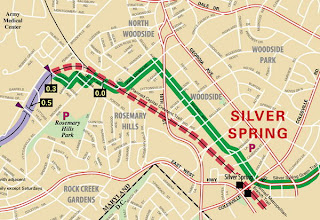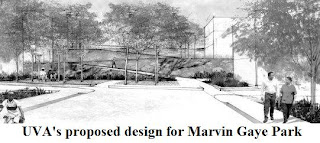 After more than five years of planning, plans for the proposed Vietnam Veterans Memorial Education Center have finally begun to surface. The project won't begin construction until 2010, but the US Congress, National Parks Service and a host of other government authorities have already shored up their plans to build the new underground museum next to Washington's famed Vietnam Veterans Memorial on the Mall near 23rd Street.
After more than five years of planning, plans for the proposed Vietnam Veterans Memorial Education Center have finally begun to surface. The project won't begin construction until 2010, but the US Congress, National Parks Service and a host of other government authorities have already shored up their plans to build the new underground museum next to Washington's famed Vietnam Veterans Memorial on the Mall near 23rd Street.
Following a rigorous nationwide design contest held in 2004, the honor of designing a complement to one of Washington’s most visited and emotionally powerful tributes went to the Polshek Partnership Architects and Ralph Appelbaum Associates. Polshek will contribute the exterior designs, while Ralph Appelbaum has been charged with designing the interior exhibits. The Center will be the third collaboration between the two firms, as they previously worked together in a similar capacity on the William J. Clinton Presidential Center in Little Rock, Arkansas and the Newseum in Washington.
 The Memorial Wall's original designer, Maya Lin, has lent her approval to their designs.
The Memorial Wall's original designer, Maya Lin, has lent her approval to their designs.Once completed, the Center will measure in at roughly 25,000 square feet and be dug into an elevated area next to the Memorial. As visitors approach the site of the east, the Center’s entrance will be masked by a “gentle recess that leads to a graceful below-grade courtyard.” The decision to build underground was made so as not to affect the resonance of the neighboring Memorial, while “protecting the elegance and beauty of our beloved National Mall.” Hargreaves Associates will serve as landscape architects on the project.
The emotional impact of the neighboring complex, however, will be felt throughout the museum, as one of the planned exhibits will serve as a showcase for the nearly 100,000 objects, remembrances and tributes left at the Memorial since its completion in 1982. Other displays included in the exhibition space will include a Wall of Faces - photographs of veterans who fell in the war - and another entitled the Legacy of Service that will highlight the contributions of servicemen and women to advance our democracy from the Revolutionary War to the present conflict in Iraq.
“[That’s] the exhibit I find most riveting,” wrote Senator Chuck Hagel in American Legion op-ed last month. “It will indelibly link those who served in the Vietnam War with their comrades-in-arms of other eras and wars through core values of duty, honor and country.” In addition to being a Vietnam veteran, Hagel is also a co-chairman of the Vietnam Veterans Memorial Fund Corporate Council.
The legislation authorizing the project prohibits use of federal funds in the planning, design and construction of the Center. The non-profit fund is currently projecting a $75-100 million budget for the project -
 only $18 million of which has already been accrued through donations. Time Warner has lent a generous $10 million to the project, while Boeing went public with a $1 million donation last July. A non-profit group serving families impacted by the war, Sons and Daughters In Touch, is also currently fundraising by collecting $1 for each of the 58,256 names on the Wall.
only $18 million of which has already been accrued through donations. Time Warner has lent a generous $10 million to the project, while Boeing went public with a $1 million donation last July. A non-profit group serving families impacted by the war, Sons and Daughters In Touch, is also currently fundraising by collecting $1 for each of the 58,256 names on the Wall.The impetus for the Vietnam Veterans Memorial Education Center came in 2003 when the law calling for the creation of Washington’s Vietnam Memorial complex was amended by President Bush. It had taken a bipartisan group of Vietnam veterans serving in the 108th Congress - including Hagel, John Kerry, John McCain, and Tom Daschle – three years to get the bill authorized.
Washington DC real estate and retail news


















































